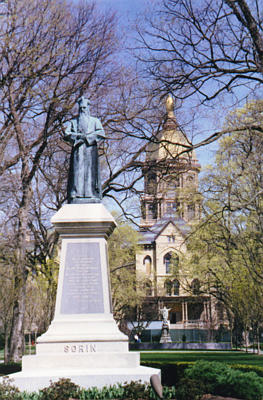
Notre Dame's Grotto / by Dorothy V. Corson

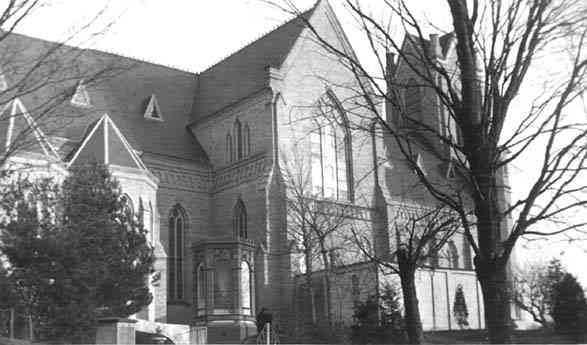
Sorin Builds First Grotto at Notre Dame in 1878
During the years 1876 and 1877, no major events related to the Blessed Virgin or the Grotto were recorded. Then references to an early Grotto being built by Sorin appeared in several 1878 entries. One entry, which confused Sorin's 1878 grotto with the present one, reported it had taken 18 years to build and was completed in 1896. The present Grotto was completed in three months.
A few earlier mentions of work in process on Sorin's Grotto were published in the September 29, 1877 Scholastic:
It is the intention of Father Sorin to erect a facsimile of the original [Lourdes Grotto] with the exception of the immense rock 200' high. The hill at the rear of the church presents every advantage for a facsimile which he wishes to reproduce with scrupulous exactness as regards, height, length, depth etc. Ever since his first visit to Lourdes in 1873 his resolution to satisfy the wishes of pious pilgrims and visitors in this respect has constantly increased. Being there is quite a concourse of pilgrims at Notre Dame from time to time the facsimile of the wonder-working Grotto cannot fail to be an object of attraction to all who visit the place.(52)
Scholastic : April 6, 1878
Work on the imitation of the Grotto Of Lourdes, just to the Northwest of the new church has commenced in a little wooded dell regarded as one of the charming spots at Notre Dame.(53)
The dedication of an earlier Grotto built by Sorin was reported in the Scholastic on August 22, 1878.(54) It was a brief entry. No description of the ceremony was included.
More paging through the Scholastics revealed that two days before the 1896 dedication of the present Grotto, the Scholastic reported:
Removal of tower-like niche which sheltered Blessed Virgin on site of old Grotto was effected, after the statue had been placed in the new Grotto. When [the] statue was taken away the niche meant nothing and was a disfigurement.(55)
If the statue fit in the new Grotto then the old Grotto niche must have been similar in size to the present one, but why were there no pictures of it?
A folder in the University Archives contained an article written for the Columbian Jubilee Celebration in 1892. It included a brief description of an earlier Grotto built at Notre Dame by Sorin in 1878.
As we leave the Seminary grounds and turn eastward toward the University, our path lies along the shore of St. Mary's Lake, on the opposite bank of which we see the barns, stables, and numerous small buildings that constitute the "home center" of the great farm.
Our path has now led us to the foot of a little hill, and we are agreeably surprised, as we are brought face to face with a facsimile representation of the Grotto of Lourdes, beautifully sculptured out of the side of the declivity. The rocks are there portrayed, while underneath is the gurgling fountain. To one side, lifted on high, is a beautiful statue of Our Lady of the Immaculate Conception, encased in an octagonal frame, the sides of which are glass, supported by stone pillars. At a little distance is the kneeling figure of Bernadette, in her quaint, pleasing Breton dress, praying to the Virgin of the Apparitions. To the left of this lovely spot is a square, three-story building -- the residence of Very Rev. Father General Sorin and his assistants. It is the mother house of the entire Congregation of Holy Cross -- the great center whence issue those directions that regulate the affairs of the order extended over the world. Such are some of the principal features of Notre Dame -- the Pride of the West . . . .(56)
This octagonal building description of Sorin's 1878 Grotto, in turn, registered as a building. The Sanborn maps of the 1880s, which had drawings of buildings on the campus, showed a small circle, labeled Grotto, in the corner of the church and sacristy. Since only buildings were indicated on the Sanborn maps, a cave-like Grotto like the present 1896 Grotto would not have been noted on them.
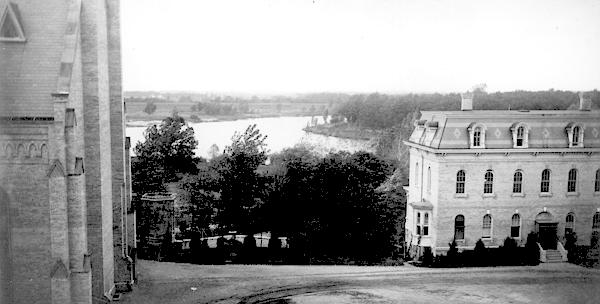
A more intense search through the archival photographs of the church and presbytery grounds finally turned up a photograph that had gone unnoticed before. A large picture(58) of the front of the Sorin Grotto, dated November 22, 1886! It was between the presbytery and the church, about ten feet from the present sacristy steps, rather than at the bottom of the hill where the present Grotto is now. Subsequently, it has turned out to be the only clear photograph in existence depicting Sorin's Grotto, the first one built at Notre Dame. It is the photograph at the beginning of this chapter.
This photograph pinpointed the exact location of the octagonal building, its size, and how far away it was from the present Grotto. Unfortunately, the photograph was cropped leaving out the area below it. There were no photographs of the lower part of Sorin's original Grotto to show what it looked like. The photograph showed only what must have been a cement representation of the arch of the Grotto cave, below and to the left side of the "octagonal frame." The written description of the portion that was not visible, "the rocks are there portrayed, while underneath is the gurgling fountain," would seem to indicate it was not the exact replica of the Lourdes Grotto Sorin intended it to be.
The words "tower niche" and the fact that it was removed because "it no longer served a purpose" were now explained. What had been referred to as a "tower niche" was this quite large octagonal, glass-enclosed building.
Until his death in October of 1893, Sorin viewed his Grotto and gardens from the windows of his presbytery rooms. His windows faced south toward the Grotto and the sacristy, and west toward the garden area, which would now be the top of the present Grotto. A hedge of evergreens bordered this elaborate garden. On the other side of the hedge the present Grotto cave was carved from a small hill that faced St. Mary's Lake. This new location proved to be the ideal spot for it.
Father Sorin speaks of his 1878 Grotto in one of his Circular Letters written on board the "St. Germaine" on his way home from France. It was written on June 4, 1883.
Then, again, I wished in real eagerness to convey to you something of my petitions, and thanks, and tears of happiness, as your representative at the Grotto of Lourdes for the more than three days that we spent there, undisturbed, alone with her! Yes: alone with her! and yet with everyone in turn of the dear family, and at times with the entire little family; and she, from the celebrated Rock, looking down attentively and motherly upon each and all, and that usually four times a day, and from one to three hours each time. Never can I forget this fourth pilgrimage to the Immaculate Mother. . . . Two hours before we left, 8,000 men had arrived from distant points, and were on their knees, in earnest supplication before their Heavenly queen; 25,000 are often seen at a time in the same act of devotion; a million, at least are expected this year. Hundreds of miracles will probably be the result and the reward of this universal and ever-increasing piety. May Heaven be praised for this glorious and saving sign among us poor mortals!
It must be a great consolation for us at Notre Dame to possess such a neat and exact fac-simile of the real Grotto of Lourdes. I will visit it oftener than I ever did, and hope many others will do the same. Dear Brother Vincent, you will come and join me there, on fine days, will you not? You know Lourdes; you will show us how much you love it . . . .(59)
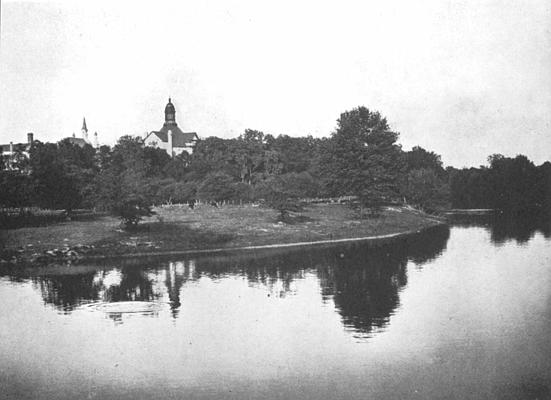
Another Grotto Mystery Solved
Sorin's circular letter contained the only known written reference he ever made to his 1878 Grotto. In it, he seems to stress the point that it was such a neat and exact fac-simile of the real Grotto of Lourdes.
However, there were indirect references to it made by others that seem to suggest that it was not the close replica of the Grotto he had planned to build, which may explain why Sorin's Grotto was also replaced seventeen years later when he was no longer around to object.
There appears to have been a bit of a mystery associated with both the earlier St. Mary's Grotto and the one Father Sorin built in 1878. No one living had ever heard of them and no books written about the campus recorded their existence.
The following excerpts from a variety of sources may explain somewhat this mystery. They also confirm that St. Mary's Grotto was Mother Angela's own inspiration.
An article was written for the Baltimore Catholic Mirror , by the same woman mentioned earlier, Mary Regina Jamison. Coincidentally, she visited both Notre Dame and St. Mary's on August 22, 1878, the day Father Sorin's Grotto was dedicated. That same day she described St. Mary's 1874 Grotto as "nearer the original than any she has seen either in this country or in Europe."
In this second article written at the same time, under the title "An Indiana Academy," Mary Regina Jamison described St. Mary's and made this interesting observation about Grottoes:
To sanctify all these natural enjoyments of the campus, there is a spiritual atmosphere pervading the whole place that would rejoice the heart of Father Faber: plenty of beautiful oratories in the house and about the play-grounds, a Grotto of Lourdes, and a facsimile of the Holy House of Loretto. Although an indoor arrangement, the grotto is the first correct reproduction of the real Grotto of Lourdes that I have seen in America. Many churches and religious houses have so-called grottoes, but they are only handsome oratories , entirely unlike the rocky spot where our Immaculate Mother appeared to Bernadette. . . . At an early date the Mother Superior intends having a grotto in the Academy grounds at a spot on the river bank [in the glen] closely resembling the natural situation of the Grotto of Lourdes . No doubt many devout persons who find it impossible to cross the ocean will then gladly make a pilgrimage to St. Mary's Grotto.(60)
Could viewing Sorin's new octagonal shrine-like Grotto have triggered Miss Jamison's remarks about inaccurate oratories? If she had seen both Grottoes at the same time, and pronounced the earlier St. Mary's Grotto as the closest replica to Lourdes in United States or Europe, what had the rest of Sorin's first Grotto looked like, and why hadn't she mentioned it?
The area allotted for the original 1874 St. Mary's indoor Grotto must have been more than three times the width of the present six by ten foot alcove, now narrowed by two closets placed on each side of it. The Lourdes statues stand alone in the small alcove. They are now silent witnesses to what must have been, from descriptions of it, a warm and appealing depiction of the Our Lady of Lourdes Grotto at St. Mary's.
The river bank in the glen was ideally suited for the outdoor Grotto Mother Angela planned to build. It was very much like the site of the Lourdes Grotto in France. The disappearance of St. Mary's Grotto eight months after Father Sorin's was dedicated -- and the abandonment of Mother Angela's plans to build a grotto in the glen -- seemed to parallel the situation ten years before. The Church name, Our Lady of Sacred Heart, and the funds Mother Angela had already collected for their proposed church, were turned over to Father Sorin to build the new church at Notre Dame in 1869. St. Mary's had to be content with having inaugurated the movement.
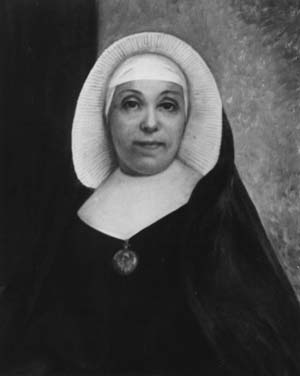 In a letter to Father Sorin, she speaks of her reason for doing so; in
order that "a great monument to our Blessed Mother [a new church] can
be erected in the United States."
In a letter to Father Sorin, she speaks of her reason for doing so; in
order that "a great monument to our Blessed Mother [a new church] can
be erected in the United States."
I now feel satisfied," she wrote, "this should be at Notre Dame in preference to Saint Mary's." She concluded: "After a while I am sure (if Providence does not grant other means) that you all at Notre Dame will help to put up a chapel in which we will be able to have Mass the year round."(61)
Perhaps Mother Angela (or Sorin) also felt there was no need for two Grottoes for pilgrimages. Having "satisfied" herself that the Grotto of Our Lady of Lourdes "should also be at Notre Dame in preference to Saint Mary's," she had hers dismantled eight months after Father Sorin built his. Once again, St. Mary's had to be content with having inaugurated a movement -- an Our Lady of Lourdes Grotto for pilgrimages on campus.
An excerpt from Sister M. Georgia Costin's, Priceless Spirit , sheds more light on the subject. She quotes Mother Compassion who, "continues into a matter for which Mother Angela has been both praised and blamed:"
Mother Angela regarded Very Rev. Father General [Sorin] as God's representative and obeyed him as such, and taught all her Sisters to do the same. No matter how much it cost her or how different her opinion was, as soon as she learned his will she submitted to it without a murmur . . . .(62)
The Mater Admirabilis Statue
History records many interesting written references to Father Sorin's beautiful way with words; his obvious devotion to Our Lady, his indefatigable spirit, and also his determination to have his own way.
Possibly the ultimate example of this audacious aspect of Father Sorin's personality turned up in an 1873 Scholastic :
It seems that Very Rev. Father General in one of his rambles through the studios of Rome came upon a marble statue which an artist was about finishing. It was Mater Admirabilis [Mother Most Admirable]. The subject represents the Blessed Mother in deep meditation, sitting by her spinning-wheel. It has always been V. R. F. Sorin's favorite representation of the Blessed Virgin. Of course he wanted it -- wanted it, right away. There was only one little obstacle to his getting it. The artist regretted to inform him that the statue was intended for the Holy Father. Well, this was rather an obstacle. Many a one would have given up the idea of ever getting the Mater Admirabilis. Not so Father General. He recommended his petition to the artist himself, and on his side prepared for a vigorous attack. But we will let him relate the incident. After speaking of several objects of art which he has purchased in Rome he speaks of this statue in a letter home:
The second is marble, a Mater Admirabilis, which was being made for the Pope: Today at 113/4 a.m. we go to a private audience: if I can prove to the Holy Father that I love very much his chosen model, etc., he may let me carry it away: I am preparing my speech.
July 2 -- Yesterday, at last, I had an audience, more delightful, if possible, than any of the nine audiences I received before. The Holy Father was more of a father to me than I had ever seen him since twenty years. A few moments afterwards, the artist, one of the first sculptors in Rome went to the Vatican with his splendid Mater Admirabilis to present it to his Holiness as a token of his veneration. (I have the following little incident in writing, from the sculptor himself.)
"But, most holy Father," said the artist, "here is the card of an American Missionary who came to my studio while I was finishing this your graceful and favorite design; I told him it was for your Holiness. I was giving it the last touch; he looked at it none the less attentively. It appears, most Holy Father, it pleased him so much that he declared he must have it. Those Americans are so positive!"
I answered; "if his Holiness permits!"
"Ah! -- Padre Sorin! -- certainly, with pleasure. I bless it for him; let him have it."
Sorin ends his letter with, I have the pleasure to announce to you that it is to be shipped this morning for Notre Dame [August , 1873].(63)
While it was an amusing incident, it left little doubt of his penchant for realizing his goals. Joseph White, author of the Sacred Heart Parish history, recounts another example of Sorin's philosophy when a close examination revealed a foot-long crack in the old church's largest bell:
Sorin reported that "a wise head" -- probably Sorin himself -- "trusting more than the rest in the Blessed Queen of the place" suggested that the broken bell be replaced by another, four times, or even five times larger, positively declaring that, while few persons would feel inclined to subscribe anything for an ordinary bell, many would be delighted to contribute for the acquisition of an extraordinary one.(64)
With characteristic determination he pursued the effort and raised the funds for the bell, which required four men to ring it. It arrived the summer of 1867, but turned out to be too large for the early church. It was placed a short distance away in a separate ground level belfry. While it may have been comical at the time, ten years later it was perfectly suited for the new church where it resides to this day impressing everyone who has seen it.
This uncanny ability Sorin had to triumph in the end was very like what has been attributed to an atmosphere on campus: "a certain force -- an energy allowed each person to perform on a level higher than usual. It came to be called the God loop. It provided good luck when least expected."(65)
It was Father Sorin himself who said, "There are moments when a vigorous stand upsets the enemy!" The enemy to Sorin was fire, pestilence, lack of funds, and anyone who didn't want to do things his way. He also said, "You can only do good by risking it." And risk it he did, on many occasions. As Father Hope put it , "there were times when Fr. Sorin was just one jump ahead of the sheriff." Yet it does seem that many of his bold actions were the result of pushing his faith to the limit to prove to himself, and others, what unbounded faith can accomplish.
As Father Hope has put it, "It is not wholly irreverent to say that Father Sorin was a tyrant. Tyrannical he was and no doubt, many were the toes stepped on. But all, in all, his energy was so great, his vision so clear, his personality so impressive, that the imposition of his will cannot be said to have been a bad thing."(66)
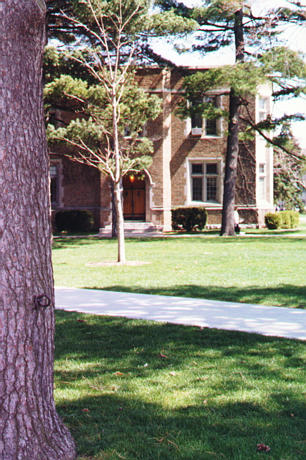 What he is said to have lacked in common sense, he made up for with a terrific
imagination. His boundless energy emanates from words written by him and
about him. It has been said that, "The world steps aside for a man
who knows where he's going," Sorin certainly had that quality.
What he is said to have lacked in common sense, he made up for with a terrific
imagination. His boundless energy emanates from words written by him and
about him. It has been said that, "The world steps aside for a man
who knows where he's going," Sorin certainly had that quality.
Yet he became an instrument of Providence because he was a man who just wouldn't give up on what he believed to be his mission in life. And because he felt his dream, was from and for Our Lady, he was willing to go where no man had gone before in fulfilling that mission. In that respect alone -- today's University of Notre Dame has proven -- he was a man of destiny.
Another example of Fr. Sorin's perseverance was his appointment as Postmaster of a Post Office at Notre Dame. In his Chronicles he wrote: "The regular passage of the mail coach would make the college better known, and causes the public highways leading to it to be carefully maintained." [guoted in Arthur Hope, Notre Dame 100 Years (Notre Dame: University Press, 1948), p.74] It would also bring revenue for the college. On January 6, 1851 after a prior attempt failed, Fr. Sorin was made Postmaster of a postal station at Notre Dame. His interest in the upkeep of the roads around Notre Dame also prompted him to seek and gain an appointment as Inspector of the Public Ways.
Evidence of the site of the original Notre Dame Post Office still remains today in the hitching rings shown in these photographs. Undoubtedly, Sorin himself used these same hitching rings. They are located in a group of pine trees about 100 feet east of Sorin's statue in front of Hurley Hall.
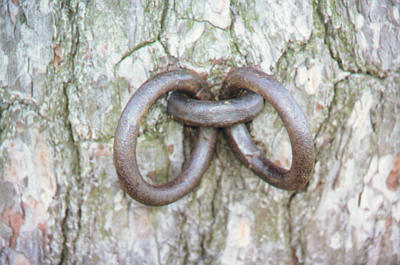
A similar reference to Mother Angela's own strong personality is in a collection of letters at the University Archives. This unguarded forthright estimation of the human side of Mother Angela's personality is interesting in terms of the universality of human nature. It was written by a general's wife, a reliable source, who was related to Mother Angela and knew her intimately. The general's wife was writing to her husband about their daughter's forthcoming trip to Europe and Mother Angela's wish to go with her. She speaks of their daughter and her "unwillingness that she not be harassed by her presence."
She would embarrass and annoy her in many way . . . for Mother Angela is unreasonable in her demands upon others and she is moreover totally ignorant of the duties of those not in her own sphere. . . . Please do not intimate that I have written in this way. (67)
Had some of Sorin's forceful personality rubbed off on Mother Angela?
The general's wife apparently accomplished her aim. The letter was written in 1873 the same year the General's daughter, Mother Angela and Father Sorin went separately to Europe and the Grotto of Lourdes, each with their own traveling companion. It was during this same trip, in August of 1873, that Sorin went to Rome and talked the Pope out of his Mater Admirabilis statue.
The Scholastic reported that another Mater Admirabilis statue was received at St. Mary's a month later, on September 13, 1873. It was sent from Europe by Mother Angela during that same trip. Father Sorin's was marble and Mother Angela's a pleasing and colorful painted statue. The existence of Father Sorin's is unknown, while the one Mother Angela sent home is still located near the South Window of the 4th floor hallway of Bertrand Hall.
As the stories told about Sorin have served to humanize him, it seems only fair that this one hundred and twenty-two year old slice of life be shared to humanize Mother Angela. Perhaps it is also only fair to conclude, that Notre Dame and St. Mary's might never have existed without two such strong autocratic personalities to found them.
Father Sorin, himself, mentioned the importance of recording a true unedited history in his own reflections recorded in his Chronicles :
. . . If these annals are to be considered as a truthful history they must either speak the truth or be silent, unless it be understood that they show only the fair side. But that would not be doing justice to the institute, nor even to the actions of Providence; because unless we see the obstacles and the difficulties of all kinds that have been met, it will not be possible to appreciate the triumph of grace. Moreover, those miseries contain lessons and warnings which will at least not be useless for our successors.(68)
The association of Father Sorin and Mother Angela was covered very nicely in Sister M. Georgia Costin's book, Priceless Spirit. "Sorin saw the great design; Angela supplied the details. He was the architect, she was the contractor." (69)
